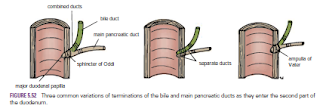Gallbladder
The gallbladder has a capacity of 30 to 50 mL and stores
bile it is a pear-shaped sac lying on
the undersurface of the liver. It, which it concentrates by absorbing water.
The gallbladder is divided into the fundus, body, and neck. The fundus is rounded and projects below the inferior margin of the liver, where it comes in contact with the anterior abdominal wall at the level of the tip of the 9th right costal cartilage. The body lies in contact with the visceral surface of the liver and is directed upward, backward, and to the left. The neck becomes continuous with the cystic duct, which turns into the lesser omentum to join the common hepatic duct, to form the bile duct
The gallbladder is divided into the fundus, body, and neck. The fundus is rounded and projects below the inferior margin of the liver, where it comes in contact with the anterior abdominal wall at the level of the tip of the 9th right costal cartilage. The body lies in contact with the visceral surface of the liver and is directed upward, backward, and to the left. The neck becomes continuous with the cystic duct, which turns into the lesser omentum to join the common hepatic duct, to form the bile duct
Gallstones
Gallstones are usually asymptomatic; however, they can give rise
to gallstone colic or produce acute cholecystitis.
Acute
Cholecystitis
Acute cholecystitis produces discomfort in the right upper
quadrant or epigastrium. Inflammation of the gallbladder may cause irritation
of the subdiaphragmatic parietal peritoneum, which is supplied in part by the
phrenic nerve (C3, 4, and 5). This may give rise to referred pain over the
shoulder, because the skin in this area is supplied by the supraclavicular
nerves (C3 and 4).
Cholecystectomy
and the Arterial Supply to the Gallbladder
the surgeon must be aware of the many variations in the
arterial supply to the gallbladder and the relationship of the vessels to the
bile ducts Before attempting a cholecystectomy operation,. Unfortunately, there
have been several reported cases in which the common hepatic duct or the main
bile duct have been included in the arterial ligature with disastrous
consequences
Gangrene
of the Gallbladder
Unlike the appendix, which has a single arterial supply, the
gallbladder rarely becomes gangrenous. In addition to the cystic artery, the
gallbladder also receives small vessels from the visceral surface of the liver.
Sonograms can now be used to demonstrate the gallbladder




No comments:
Post a Comment